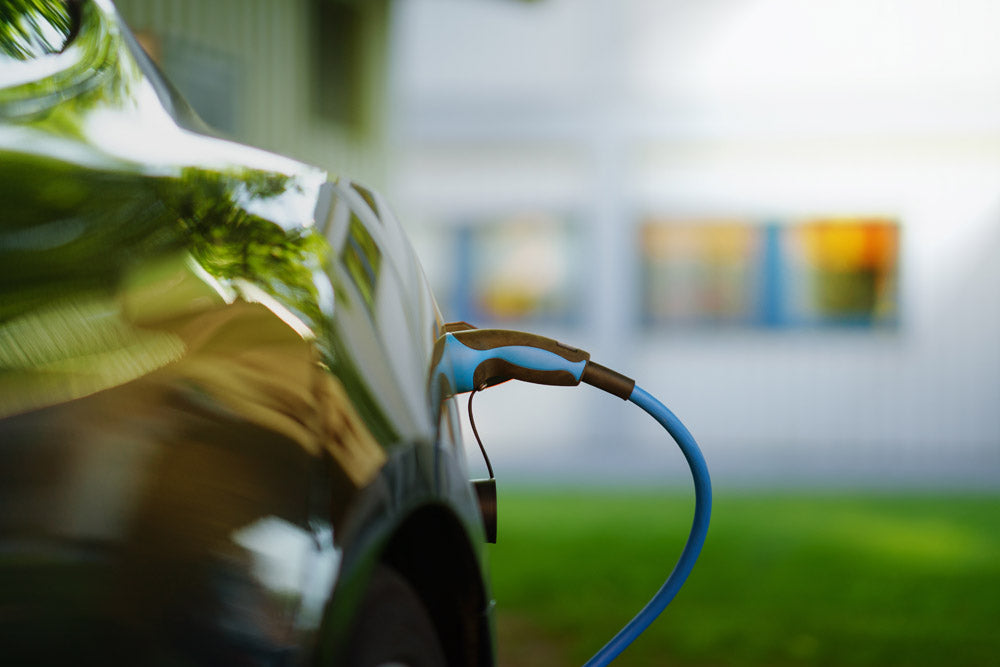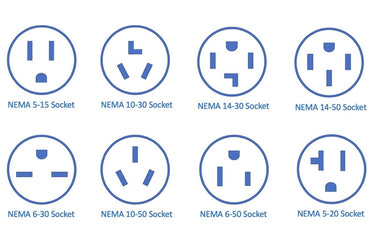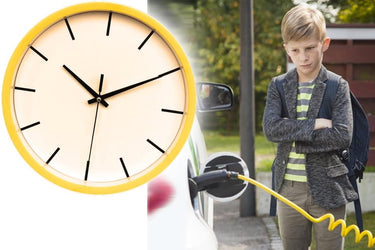
NEMA Sockets for EV Charging

NEMA Sockets for EV Charging in your own home.
If you live in the US, you may one of these key NEMA sockets for EV charging in your garage. This article looks at these various interfaces, how are be used to charge your electric vehicle at home. It also covers which ones are most effective for maximizing EV battery recharging. You will, of course, also need an EV charger! Either one supplied from your car dealer, or one you’ve bought yourself. You should look for have a complete EV home charging solution. So, make sure the charger you buy has the correct plug for the socket you intend to use! The explanation below should bring you up to speed on how it all fits together. You can also refer to our Gallery of EV Socket Types for a stylised comparison of NEMA plug interfaces.
Introducing NEMA sockets
NEMA stands for ‘National Electrical Manufacturers Association’. NEMA have a range of specifications for electric plugs and sockets used with the AC electricity supply in the US. The specifications cover electrical current from 15 to 60 Amps and voltage from 125 to 600 volts. Every electrical socket—whether inside your home, garage or externally accessed—is covered by one of these NEMA specifications. There is quite a broad range of sockets. Because of this we’ll look at only the NEMA sockets for EV charging you are most likely to have. And how efficiently each will charge your EV!
NEMA 5-15 Socket

The NEMA 5-15 Socket is the most common electrical receptacle in homes in the US. It is a polarized 120V, 15 Amp socket configured as Hot, Neutral, Ground. In your garage, this socket could be used for just about any common task. Typical applications include connecting a compressor to inflate car or bike tires.
The NEMA-15 socket can also be used to charge just about any EV as well. This is true whether it is a full Battery Electric vehicle (BEV) or a Plug in Hybrid (PIHV). Using this standard type of socket to charge your EV is known as Level 1 charging. The problem with this NEMA socket for EV charging, however, is the amount of time it takes to charge your vehicle. The NEMA 5-15 socket only supplies electricity at 120 Volts with 15 Amps of current. At this rate a modern EV such as a Tesla Model 3 could take up to 50 hours to charge. That’s approximately 4.5 miles of range per charging-hour.
Most of the other sockets described in this article provide 240 volts—twice the current delivery. Therefore they are much better suited to rapid EV charging!
NEMA 10-30 Socket

The NEMA 10-30 is where it starts to get interesting for EV charging! This is a three-wire, 240v 30 Amp socket configured as ‘Hot, Hot, Neutral’. This socket was standard for practically every house built in the USA prior to 1996. It was typically installed at a single point in the garage for a very specific purpose: to run the electric clothes dryer.
The good news is that you probably have one sitting behind your clothes dryer right now. This socket is perfect for charging your EV at home. This is because it gives you easy access to what is known as Level 2 fast charging. There is one obvious benefit of using your existing ‘dryer-plug’. That is that you don’t have to pay an electrician to install a dedicated 240v circuit to accommodate your electric vehicle charging requirements. Just swap your dryer plug for your charger when you get home from work each evening. A 240v 30A charger connected to a NEMA 10-30 socket adds around 25 miles per charge hour to your EV. This rate fully charges a modern EV, from empty, in around 10 hours.
NEMA 14-30 Socket

The NEMA 14-30 is a four-wire 240v, 30Amp socket, configured as ‘Hot, Hot, Neutral, Ground’. This is the socket that replaced the traditional NEMA 10-30 as the ‘dryer-plug’ after 1996. Because of this it is found in millions of US garages. The NEMA 14-30 is perfect for Level 2 EV charging. If you already have one installed, again simply unplug the dryer and connect up your EV charger in its place. This socket has the same basic electrical characteristics as the 10-30 / 240v 30A. It can also fully charge a long-range (over 250 miles) EV in around 10 hours.
NEMA 14-50 Socket

The NEMA 14-50 is a four-wire, 240v 50 Amp socket configured as ‘Hot, Hot, Neutral, Ground’. A 14-50 is usually installed to enable higher power devices. Electric cooking ranges or other high current device, such as a welders are typical applications. It’s also been used extensively for connections to mobile homes and other large recreational vehicles.
The NEMA 14-50 is also very useful for charging an EV. With the appropriate charger, this socket can be used to completely refill the batter of a modern EV in about 7 hours or less. The issue with the NEMA 14-50 is that most homes and garages don’t have one! Also, as it’s a 50 Amp system, a new installation requires considerable care. This is to ensure that the capacity of the main power panel is not exceeded. An NEMA 14-50 should only be installed by a professional electrician. They can also undertake an audit of existing home power consumption.
NEMA 6-30 and 6-50 Sockets

NEMA 6-30 and NEMA 6-50 sockets are both 240 v, with the 6-30 suitable for delivering 30 Amps and the 6-50, providing 50 Amps. They are three-wire systems configured as ‘Hot, Hot Ground’. These interface types are not very common, and are often adapted from wiring originally installed and connected to a NEMA 5-15 socket. For safe implementation of this conversion, further wiring and circuit breakers need to have been suitably connected to the electrical panel. Pay careful attention to the diameter of the wiring, to ensure that it is genuinely suitable for the sustained 30 or 50 Amps that an EV charging device will draw. It is advisable in this instance to have an electrician check the socket and wiring.

If you already have either the NEMA 6-30 and NEMA 6-50 correctly and safely installed, they are well-suited to charging an electric vehicle. These sockets will recharge a modern EV in around 7 to 10 hours, depending on which current used. For new installations, a NEMA 14-50 socket and wiring would be a preferable option, assuming that the associated power panel can support the extra 50 Amps.
NEMA 10-50 Socket

Although the NEMA 10-50 socket is not very common, some domestic garages used this interface prior to 1996. Like the NEMA 10-30, it’s a three-wire, 240v socket configured as ‘Hot, Hot, Neutral’, but with a 50 Amp capacity. As not many EV chargers support this style of socket, if you do have this system it’s may be better to change the socket to a NEMA 6-50 style. As a 50 Amp capacity, the NEMA 10-50 is capable of fully recharging a modern EV in approximately 7 hours.
NEMA 5-20 Socket

Lastly, the NEMA 5-20. This is very similar to the NEMA 5-15, although much less common. It was occasionally installed in garages or homes to support devices such as air conditioning or low-power welders. It is a 120v 20 Amp system configured as ‘Hot, Neutral, Ground’. As it draws only 120v it can only deliver Level 1 EV charging and, therefore, it will take too long to charge a modern EV.
Key Points: NEMA Sockets for EV Charging
There’s a range of US electrical sockets, one or more of which you’ll find in your garage. All of the 240v interfaces are suitable for the fast, Level 2 charging necessary for modern EVs with long range, high-density batteries. Many US homes have either a NEMA 10-30 or 14-30 dryer-plug already installed in the garage. Happily, these are perfect for EV charging without the additional costs and potential disruption of installing a new socket, as discussed in our article, How to Prepare for Home EV Charging. For new, dedicated installations, the NEMA 14-50 socket is preferable, provided the home’s electrical wiring and power panel can cope and it won’t result in a circuit overload when charging the EV.
Note: This article has been written as a non-professional, general explanation of US socket interface types and EV charging rates. It is in no way intended as electrical advice or as a substitute for consultation with a licensed electrician, which is highly recommended.
You might also like to read…
-
/







